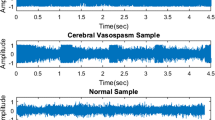Abstract
Continuous monitoring of brain hemodynamics is important to quickly detect changes in healthy cerebral blood flow, helping physician decision-making in the treatment of the patient. Resistivity changes in the brain happen as a result of the pulsatile characteristic of the blood in the arteries or pathological conditions such as ischemia. We developed a dynamic model of cerebral circulation capable of portraying variations in resistivities in arteries within a cardiac cycle. From the hypothesis that the resistivity changes in the brain can be detected by Electrical Impedance Tomography (EIT), we included this model as prior information in time-difference image reconstruction algorithm. With this prior information, image reconstruction of the brain with pre-existing ischemia was possible, showing that EIT is a potential technique for brain hemodynamic monitoring.
Access this chapter
Tax calculation will be finalised at checkout
Purchases are for personal use only
Similar content being viewed by others
References
Puig B, Brenna S, Magnus T (2018) Molecular communication of a dying neuron in stroke. Int J Mol Sci 19:2834
Bor-Seng-Shu E, Kita WS, Figueiredo EG et al (2011) Cerebral hemodynamics: concepts of clinical importance. Arq Neuro-Psiquiatr 70:352–356
Holder DS (2005) Electrical impedance tomography: methods, history and applications, 1st edn. IOP Publishing Ltd, Cornwall, UK
Proença M (2017) Non-invasive hemodynamic monitoring by electrical impedance tomography. PhD thesis, École Polytechnique Fédérale de Lausanne
Hammond D, Price N, Turovets S (2017) Construction and segmentation of pediatric head tissue atlases for electrical head modeling OHBM. Vancouver, Canada
Gonzalez R, Woods R (2008) Digital image processing, 3rd edn. Pearson Prentice Hall, Londres
Geuzaine C, Remacle JF (2009) Gmsh: a three-dimensional finite element mesh generator with built-in pre- and post-processing facilities. Int J Numer Methods Eng 79:1309–1331
Kaipio J, Somersalo E (2005) Statistical and computational inverse problems, 1st edn. Springer, New York
Bullitt E, Zeng D, Gerig G et al (2005) Vessel tortuosity and brain tumor malignancy: a blinded study. Acad Radiol 12:1232–1240
Melis A (2017) Gaussian process emulators for 1D vascular models. PhD thesis, The Department of Mechanical Engineering—The University of Sheffield
Alastruey J, Parker KH, Peiró J et al (2007) Modelling the circle of Willis to assess the effects of anatomical variations and occlusions on cerebral flows. J Biomech 40:1794–1805
Visser KR (1989) Electric properties of flowing blood and impedance cardiography. Ann Biomed Eng 17:463–473
Gabriel S, Lau RW, Gabriel C (1996) The dielectric properties of biological tissues: III. Parametric models for the dielectric spectrum of tissues. Phys Med Biol 41:2271–2293
Andreuccetti D, Fossi R, Petrucci C (1997) An Internet resource for the calculation of the dielectric properties of body tissues in the frequency range 10 Hz–100 GHz. Based on data published by Gabriel C et al. in 1996
Fernandez-Corazza M, Ellenrieder N, Muravchik CH (2011) Estimation of electrical conductivity of a layered spherical head model using electrical impedance tomography. J Phys: Conf Ser 332:012022
Horesh L (2006) Some novel approaches in modelling and image reconstruction for multi-frequency electrical impedance tomography of the human brain. PhD thesis, Department of Medical Physics—University College London
Cheng KS, Isaacson D, Newell JC et al (1989) Electrode models for electric current computed tomography. IEEE Trans Biomed Eng 36:918–924
Silva OL, Lima RG, Martins TC et al (2017) Influence of current injection pattern and electric potential measurement strategies in electrical impedance tomography. Control Eng Pract 58:276–286
Beraldo RG (2019) Desenvolvimento de um modelo dinâmico da circulação cerebral para tomografia por impedância elétrica. Master’s thesis, Universidade Federal do ABC
Vauhkonen P (2004) Image reconstruction in three-dimensional electrical impedance tomography. PhD thesis, University of Kuopio
Findlay JM, Nisar J, Darsaut T (2016) Cerebral vasospasm: a review. Can J Neurol Sci 43:15–32
Romsarueva A, McEwan A, Horesh L et al (2006) MFEIT of the adult human head: initial findings in brain tumours, arteriovenous malformations and chronic stroke, development of an analysis method and calibration. Physiol Meas 27:S147
Acknowledgements
The MR brain images from healthy volunteers used in this paper were collected and made available by the CASILab at The University of North Carolina at Chapel Hill and were distributed by the MIDAS Data Server at Kitware, Inc.
The authors gratefully acknowledge funding from the Coordenao de Aperfeioamento de Pessoal de Nvel Superior—Brasil (CAPES)—Finance Code 001 and The So Paulo Research Foundation (FAPESP), processes 2017/18378-0 and 2019/09154-7.
Author information
Authors and Affiliations
Corresponding author
Editor information
Editors and Affiliations
Ethics declarations
The authors declare that they have no conflict of interest.
Rights and permissions
Copyright information
© 2022 Springer Nature Switzerland AG
About this paper
Cite this paper
Beraldo, R.G., Moura, F.S. (2022). Time-Difference Electrical Impedance Tomography with a Blood Flow Model as Prior Information for Stroke Monitoring. In: Bastos-Filho, T.F., de Oliveira Caldeira, E.M., Frizera-Neto, A. (eds) XXVII Brazilian Congress on Biomedical Engineering. CBEB 2020. IFMBE Proceedings, vol 83. Springer, Cham. https://doi.org/10.1007/978-3-030-70601-2_266
Download citation
DOI: https://doi.org/10.1007/978-3-030-70601-2_266
Published:
Publisher Name: Springer, Cham
Print ISBN: 978-3-030-70600-5
Online ISBN: 978-3-030-70601-2
eBook Packages: EngineeringEngineering (R0)




